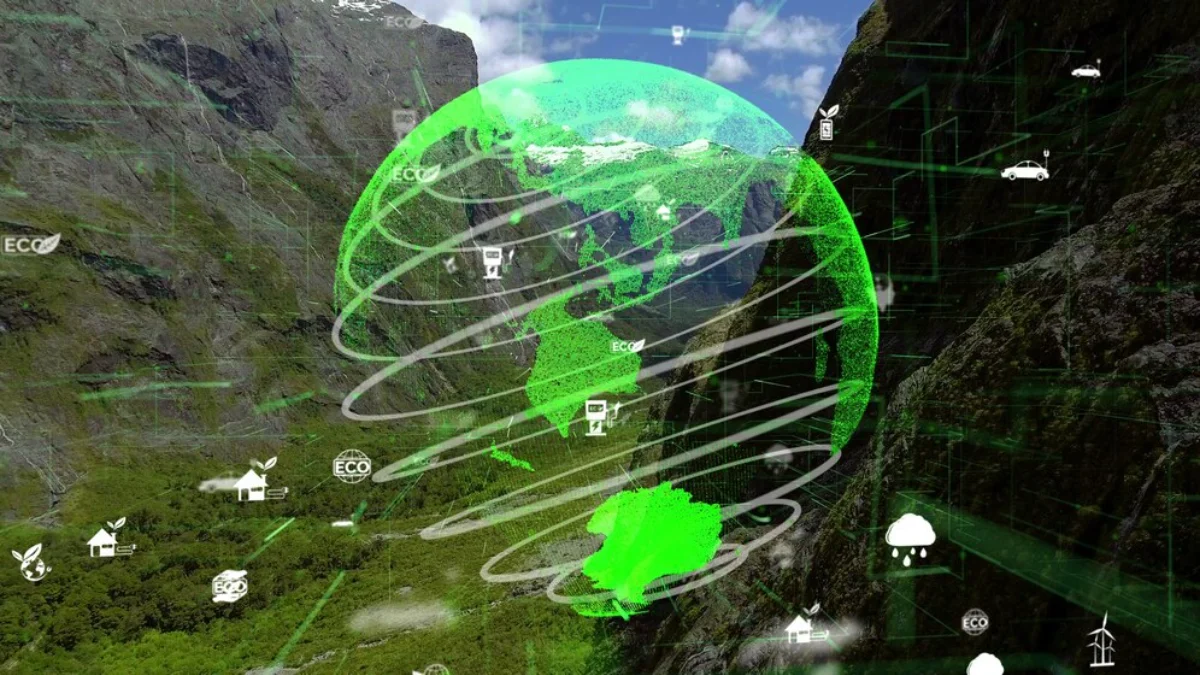The Technology Blog

How AI is Fighting Climate Change
As the climate crisis speeds up, technology is key in finding solutions. AI climate solutions are powerful tools that help tackle global warming. They provide data-driven insights, boost energy efficiency, and improve sustainable practices across many industries. By using machine learning for sustainability, scientists, businesses, and policymakers can make better decisions to cut carbon footprints and enhance environmental resilience.
AI in environmental science is already used to predict climate patterns, improve renewable energy, and monitor deforestation and pollution. But what impact can AI really have? This article looks at how AI supports climate action, its benefits, and the challenges we must face to unlock its potential.
The Role of AI in Climate Change Mitigation

How AI Helps Combat Climate Change
AI is helping fight climate change in various ways:
- Enhancing climate modelling – AI analyses large climate data sets to predict changes more accurately.
- Optimising energy efficiency – Machine learning helps reduce energy use in industries and homes.
- Improving renewable energy – AI increases efficiency in solar, wind, and hydropower generation.
- Tracking carbon emissions – AI tools help businesses and governments manage their carbon footprints.
- Predicting natural disasters – AI models analyse weather patterns to forecast hurricanes, wildfires, and floods.
- Supporting sustainable urban planning – AI aids planners in creating energy-efficient, eco-friendly cities.
- Facilitating climate-conscious supply chains – AI optimises resource use and reduces waste in logistics and manufacturing.
By adopting AI climate solutions, industries can move towards sustainable practices while protecting the environment.
Quick Guide: How AI Combats Climate Change
- Climate Forecasting: AI predicts weather patterns and future risks.
- Energy Efficiency: Optimises solar, wind, and smart grid performance.
- Carbon Reduction: Tracks and lowers emissions in industry and transport.
- Sustainable Agriculture: Reduces waste and improves yields with precision farming.
- Climate Policy & Reforestation: Helps develop green policies and supports ecosystem restoration.
Pro Tip
Use AI not just to predict—but to prevent. Integrating AI early in your sustainability strategy helps identify inefficiencies before they become costly environmental problems.
Important
AI is only as good as the data it learns from. For impactful climate solutions, invest in clean, diverse, and unbiased datasets—especially in developing regions most affected by climate change.
AI-Powered Climate Modelling and Prediction
1. Enhancing Weather Forecasting
Traditional climate models use historical data and complicated calculations, which can be slow and error-prone. AI in environmental science is changing weather forecasting by:
- Analysing large datasets from satellites, sensors, and historical records.
- Providing real-time predictions of extreme weather events like hurricanes and heatwaves.
- Helping communities prepare for disasters, reducing economic and human losses.
2. Predicting Climate Change Impacts
Machine learning assesses how rising temperatures and changing weather affect ecosystems, agriculture, and health. These predictions guide policymakers in developing adaptation strategies, such as:
- Identifying areas at risk for droughts and heatwaves.
- Predicting rising sea level impacts on coastal cities.
- Suggesting sustainable land and water management practices.
- Modelling future carbon emissions and their long-term effects.
AI in Renewable Energy Optimisation
1. Increasing Efficiency in Solar and Wind Energy
AI systems optimise renewable energy sources. Machine learning for sustainability enhances:
- Solar power output – AI adjusts solar panel positions based on weather forecasts.
- Wind energy generation – AI predicts wind patterns to improve turbine efficiency.
- Energy grid management – AI balances renewable energy production with demand.
- Battery storage – AI enhances energy storage systems for better renewable energy use.
2. Smart Grid Technology
Smart grids use AI to improve electricity distribution, cut energy waste, and lower emissions. AI helps by:
- Predicting energy demand and adjusting supply.
- Identifying energy loss areas and enhancing efficiency.
- Integrating various renewable sources into the grid.
- Supporting decentralised energy where households can sell excess solar energy.
AI for Carbon Footprint Reduction

1. AI in Industrial Emissions Monitoring
Industries are major carbon emitters. AI helps by:
- Tracking and analysing greenhouse gas emissions in real-time.
- Finding ways for factories to lower emissions.
- Boosting energy efficiency in manufacturing and logistics.
- Creating AI-driven carbon offset strategies aligned with sustainability goals.
2. AI in Sustainable Agriculture
Agriculture contributes significantly to methane and CO2 emissions. AI solutions help farmers adopt sustainable practices by:
- Optimising fertiliser use – Cutting excess nitrogen emissions.
- Precision farming – AI drones monitor soil health and plant growth to reduce waste.
- Reducing food waste – AI predicts crop yields and optimises food distribution.
- Improving livestock management – AI tracks animal health and feeding to lower methane emissions.
3. AI in Smart Transportation
Transport is a major source of emissions. AI transforms this sector by:
- Optimising traffic flow – Reducing congestion and fuel use in cities.
- Enhancing EV efficiency – AI improves battery performance and route planning.
- Cutting logistics emissions – AI streamlines delivery routes to save fuel.
- Developing autonomous electric vehicles – AI self-driving cars aim to reduce emissions by optimising driving habits.
Challenges and Ethical Considerations in AI Climate Solutions
1. High Energy Consumption of AI Models
While AI aids sustainability, large models demand significant computing power, raising energy use. We must balance AI’s benefits with its carbon footprint.
2. Data Bias and Accuracy
AI models depend on data. If the data is biased or incomplete, predictions can be wrong, leading to ineffective policies. It’s crucial to train AI on diverse, high-quality datasets.
3. Integration with Existing Systems
Many industries still use traditional methods. Adopting AI solutions needs major infrastructure upgrades and workforce training.
4. Ethical Use and Privacy Concerns
AI surveillance for environmental monitoring must follow privacy laws and ethical guidelines, especially when tracking emissions and energy use.
The Future of AI in Climate Action
1. AI-Powered Climate Policy Development
Governments are starting to use AI for better climate policies. AI models help policymakers:
- Assess the long-term effects of environmental policies.
- Simulate various climate scenarios and outcomes.
- Identify cost-effective carbon reduction strategies.
2. AI-Driven Carbon Capture Technologies
AI is being integrated into carbon capture and storage (CCS) systems, optimizing CO2 emissions capture from industries and lowering atmospheric carbon levels.
3. Expanding AI in Circular Economy Practices
AI helps reduce waste by improving recycling and resource allocation. Some examples include:
- AI-powered sorting systems – Boosting waste separation efficiency.
- Predictive waste management – Forecasting waste production to optimise collection.
4. AI in Reforestation and Ecosystem Restoration
AI monitors deforestation, tracks biodiversity, and supports reforestation by:
- Mapping forest health with satellite images.
- Predicting areas needing reforestation.
- Assisting in automated tree planting using drones.
FAQs About AI and Climate Change
Q1: Can AI really reduce carbon emissions?
A: Yes. AI helps industries monitor, predict, and reduce emissions through smart energy use, route optimisation, and real-time analytics.
Q2: Is AI energy-efficient, or does it contribute to the problem?
A: Some AI models are energy-intensive, but many sustainable AI initiatives are focused on minimising energy use and offsetting emissions with green computing.
Q3: How does AI support renewable energy growth?
A: AI predicts energy demand, forecasts weather, and optimises energy storage—making solar, wind, and hydro more reliable and efficient.
Q4: Are there real-world examples of AI fighting climate change?
A: Yes—Google uses AI to cut data centre energy use, and IBM’s Green Horizon initiative predicts air pollution and energy demand in smart cities.
Q5: Can small businesses use AI for sustainability too?
A: Absolutely. Affordable AI tools now exist for energy monitoring, smart logistics, and even AI-powered recycling systems for SMEs.
AI: A Powerful Ally in the Fight Against Climate Change

AI has emerged as a game-changer in the fight against climate change, offering innovative solutions to enhance sustainability, improve efficiency, and mitigate environmental damage. From optimising renewable energy and reducing carbon footprints to predicting climate impacts and supporting policy development, AI is helping industries and governments take meaningful climate action. However, challenges such as data accuracy, ethical considerations, and high energy consumption must be addressed to maximise its potential. As AI technology continues to evolve, its role in climate resilience will only grow stronger, paving the way for a more sustainable and environmentally responsible future.









